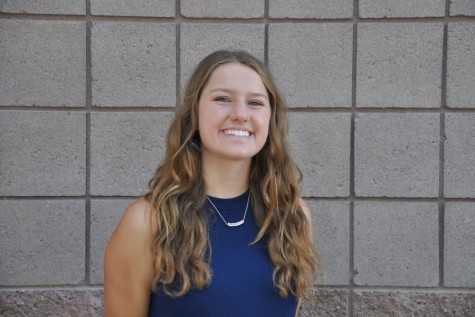Many people do not understand the severity of mental illnesses, let alone notice them. Those who suffer often go undetected, in the same hallways we walk every day.
Mental illness misconceptions need true definitions
It’s a similar scene played out in classrooms all over the world. A student has over-prepared for an exam, crammed flash cards and reviewed notes for 48 consecutive hours.
Ever since this student was little, every time the spotlight was on them or they were in a high-pressure situation, they folded. They failed.
In some cases this person just lacks confidence, but as modern medicine and the study of the human psyche evolves, so does society’s understanding that this student has a legitimate condition. They battle anxiety.
As a mental illness, anxiety is highly misunderstood. According to the Mayo Clinic, people with anxiety “frequently have intense, excessive and persistent worry and fear about everyday situations.”
As with many other mental illnesses, anxiety is not a problem until it becomes chronic and affects everyday activities. According to a study conducted by the National Institute of Mental Health, anxiety is diagnosed when a person has excessive worries about everyday problems for six months.
People with anxiety often avoid everyday activities and loose interest in their hobbies. Anxiety is not just an uncomfortable feeling, but an urgent feeling of danger when performing daily tasks.
The Mayo Clinic lists the symptoms as, but not limited to: persistent worrying, inability to let go of worry or to relax, and obsessing over the most negative possible outcomes. Physical symptoms include: fatigue, muscle tension, sweating, trouble sleeping, and headaches.
Depression:
Coming home in a bad mood is normal. Being upset from time to time is normal. Wanting space and time alone is normal. But hopeless, taunting sadness and unsubsiding pain is not normal.
While many think that depression is just a case of the blues, it is much more than that. Depression is defined by teenmentalhealth.org as, “a dysregulation of the brain function that controls emotions (or moods). It is a mood disorder characterized by intense and persistent negative emotions.” Depression is misunderstood and undermined; many people have misconceived it as a state of mind that will pass.
Teendepression.org is a website dedicated to educating the general public on depression specifically in teenagers. According to data provided by this website, about 20 percent of teens will experience depression before reaching adulthood. Counselor Kirstin Gregg explains what she sees as part of her profession, “people who are depressed have a difficult time finding joy in their life”.
Depression is extremely detrimental to everyday life. “If you are unable to go through your day and get things done and find joy in life, that’s a problem” says Gregg. It makes normal activities much more difficult and exhausting. Symptoms of depression include, but are not limited to: persistent sadness, empty feelings, intense pessimism, loss of interest in hobbies, fatigue, overeating/appetite loss, and thoughts of suicide.
OCD:
Double-checked and the iron is definitely off, she thought.
Triple checked.
Turn it on and off again, just to be make sure.
The iron is off, but the inevitable urge to check again remains. It’s not right.
Obsessive Compulsive Disorder is a mental illness that must be split into two parts to be understood; the obsession and the compulsion make up the illness as a whole. The first part, the obsession, is defined by teenmentalhealth.org as “persistent, intrusive and unwanted thoughts, images or impulses (urges).” The second part, the compulsion, is an uncontrollable desire to carry out these actions.
OCD of one person cannot be fully understood by another because it is specific to the individual. Gregg explains her perception of the illness as “obsessions that you feel that you have to do in order to take control of your life.” People with OCD often find small things to worry about, such as obsessing over pen strokes or number patterns. They also have rituals which they must perform no matter what.
According to the National Alliance on Mental Illness, more than 2 percent (1 out of every 40 people) will be diagnosed with OCD throughout their lives. Although this may seem like a small percent of the population, many go undiagnosed. About 60 percent of adults with a mental illness and 50 percent of youth have gone untreated.
School Shootings have desensitized America
On an April morning in 1999, the world changed. Columbine High School endured a school shooting that shocked America. This incident astounded the entire nation and caused a widespread feeling of panic and sorrow. Like Pearl Harbor or 9/11, it was such a shocking event that people remember exactly where they were and what they were doing when they heard the news.
Since 2013, there has been 168 school shootings alone in the United States. The incident at Columbine was displayed over the media and nationwide news for several months after. Yet, the most recent 168 school shootings were not all shown over the media nationwide for months on end. These events were plastered for a day or week max then ceased to be mentioned again other than the cities where the events occurred.
With the amount of school shootings over the past couple of years it is assumed school shootings have become in a sense normalized and not a total shock to the public. The threat of violence on campus is a real thing that haunts school administrators. Principal Dan Serrano, who used to teach special education, said “when I first started teaching a shooting at a school was really rare.”
Twenty years later, Serrano then references yet another shooting taking place at Independence High School only forty-three miles away from PHS. This shooting ended in a murder and suicide. Last October, another school shooting took place at Northern Arizona University startling the state of Arizona resulting in three injuries and a death of a student.
“I do think they have become in a sense, normalized,” English teacher Mara Schultz said. “I feel like the only one that is the exception is Sandy Hook, just because the kids were so young.”
Sophomore Ryan Whitmire agreed with Schultz. “I think they have definitely become normalized, but I don’t see a lot done to stop them,” he said. “We just kind of accept them.”
With the numerous shootings taken place there should be substantial efforts put in place to prevent them. Yet, this is not so the case with minimal efforts to change the situation.
Decades ago mass shootings were few to none. Nowadays, Americans have seem to become desensitized towards gun violence and tend not to look twice at mass shootings.
There are several solutions that can be instituted to prevent these school shootings from repeatedly occurring. Stricter gun laws and more in-depth background checks should be set in place to prevent the unreasonable and mentally unstable from owning a firearm. While arming teachers and overall schools would result in a safer atmosphere, but has its own positives and negatives. Shooters are well aware schools are a “gun-free” zone and use that to their advantage. To top it off, there should be stricter school security no matter the current safety of the area. With the realism of school shootings becoming normalized precautions and steps should be taken into preventing this normalization.




